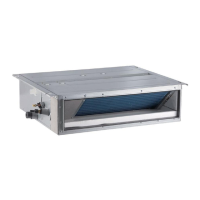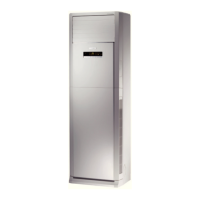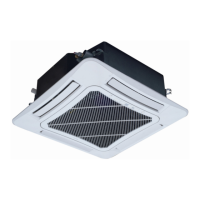GMV5 DC INVERTER VRF UNITS SERVICE MANUAL
200
Note: Keep wiring identical to factory installation. Control varies with compressors. Wrong
wiring or inverse connection of the compressors may cause damage to units.
Cautions on replacement of compressors:
1) Before installing new compressors, remove the sealing rubbers and weld the compressors with
corresponding pipes. During welding, charge nitrogen into the pipes. Since compressors‘ suction
and discharge pipes are made of copper plated steels, you need to prepare special welding rods
(containing 5% or more silver). Welding clearance should be controlled within 0.1~0.3mm, avoiding
blockage or loose welding. During welding, control pipe openings from being over-heated.
2) After the pipeline system is welded, use special supports and bolts to fix the compressors, ensuring
stability of the compressors during running.
3) Power lines of the compressors should be wired following the factory installation. You can refer to
the wiring diagram. Phase sequence error and inverse connection of compressors are not allowed.
In particular, if there are two inverter compressors GMV-400WM/B-X and GMV-450WM/B-X that
need replacement, pay attention to wiring. Control varies with compressors. Inverse connection of
the compressors may cause damage to units.
Step 12: System check.
1. Check welding joints for abnormalities.
2. Charge nitrogen into the system for leakage detection. If you are maintaining ODUs and the IDU
system is normal, you can charge nitrogen into the ODU system only. Note that nitrogen should be
charged from both the high pressure side and low pressure side. You are advised to charge through all
valves. Nitrogen pressure should be larger than 20 kgf. Then, charge soapsuds into the system and
check specially the weld joints for leakage.
3. Finally, charge nitrogen into the system again for pressure check. Close all valves and keep system
pressure up to 25 kgf for more than 12 hours. If the pressure remains unchanged, you can extract all air.
Otherwise, you should find the leakage points first.
※ While determining system pressure change, take temperature into consideration. For 1°C
temperature change, pressure will change by 0.01 MPa accordingly. Suppose that nitrogen pressure
reaches 2.5 MPa at 30°C, 12 hours later, temperature decreases to 25°C and pressure decreases to
2.43 MPa accordingly. The system is regarded qualified despite the pressure decrease.
Step 13: Fill lubricant.
Quantity of lubricant that is needed is subject to the total draw amount from compressors and parts. The
fill amount should be equivalent to the draw amount. If the draw amount is too little or too much, clear all
lubricant first and determine fill amount by referring to Appendix 1 (accessory list).
Fill amount is determined by two factors: the number of compressors replaced and the draw amount
from each part. For replacement of one compressor, 1.5 L lubricant should be added. The fill amount
should be equal to or a little larger than the draw amount.
Examples:
(1) For GMV-450WM/B-X units, one compressor is replaced; lubricant that is drawn from the gas
separator is 1 L and lubricant that is drawn from the oil separator is 0.7 L. Then, the total required
amount is 1.5 L + 1 L + 0.7 L = 3.2 L. You should add 3.2 L lubricant into the system.
(2) For GMV-280WM/B-X units, one compressor is replaced; gas separator and other filters are replaced
as well; pipes have been charged with nitrogen for cleaning. Since the maintenance work involves most
of the parts, there is little residual lubricant inside the system. You are advised to clear the residual
lubricant and add 3.5 L new lubricant into the system (determined by referring to the accessory list).
Specific procedure is as follows:
1) GMV5 series units use FVC68D lubricant. Make sure to confirm the trademark of the lubricant first.
Lubricant of other trademarks is not allowed.
2) Open all valves and extract air for 30 minutes or longer.
3) Connect a rubber hose to the oil checking valve at one end. Open the container that holds lubricant
and pour lubricant into a measuring glass. If the glass is too small to hold the lubricant of a required
amount, measure the lubricant portion by portion. Record volume of each portion and then put the
other end of the rubber hose into the glass.
4) Keep on extracting air and open the oil checking valve. The lubricant will be pressed into the low
pressure side of units.
5) If the lubricant is added portion by portion, close the oil checking valve first and then measure
another portion of lubricant. In the course of repeated measuring and adding, keep the extraction
action.

